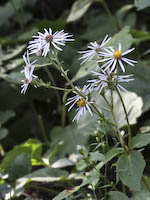Large-leaved Aster
Eurybia macrophylla
(formerly Aster macrophyllus) |
 Other scientific names:
Aster macrophyllus, Aster ianthinus, Aster multiformis, Aster nobilis, Aster riciniatus, Aster roscidus, Aster violaris Other scientific names:
Aster macrophyllus, Aster ianthinus, Aster multiformis, Aster nobilis, Aster riciniatus, Aster roscidus, Aster violaris

French names:
Aster à grandes feuilles

Family:
Composite Family (Asteraceae)

Group:
Asters

Distinctive features:
In forests. Large basal leaves. Colonies of basal leaves with no flower stems. Flat-topped flower head. Large flowers.

Similar species:
•
Flat-topped White Aster (Doellingeria umbellata) - Leaves are lance-shaped.
•
Heart-leaved Aster (Symphyotrichum cordifolium) - Basal leaves similar, but flowers are in a rounded panicle.

Flowers:
Summer, Autumn; White, Blue/Violet; 7 or more parts (petals); 2-4cm in diameter. Ray Flowers: 9-16, white, violet or lavender. Disc flowers: 20-40, yellow becoming purple. Flowers are in a flat-topped corymb, one to many flowers per plant.

Leaves:
Alternate, Simple, Toothed; Basal leaves very large, thick, rough, and somewhat heart-shaped (5-15cm), margins saw-toothed, upper and lower surfaces smooth or hairy/sticky. Upper stem leaves oval to lance-shaped, gradually smaller higher on the stem.

Height:
Up to 1 m (1-2 ft)

Stem:
Somewhat zig-zag in form. Stalks of the flower cluster have minute glands (need magnifying lens). Stem can be purplish sometimes.

Habitat:
Forests; Forests. Widespread throughout Ontario.

Grows in Sun/Shade:
Shade

Lifespan:
Perennial.

Books:
Newcomb's Wildflower Guide: 454
Peterson's Field Guide to Wildflowers: 354
ROM Field Guide to Wildflowers of Ontario: 166

Native/Non-native:
Native

Status:
Common.

Notes:
This Aster is found in forests in many areas. Its large basal leaves are distinctive, often forming large colonies without flowering stems. It's often one of the first asters to bloom.

Origin and Meaning of Names:
Scientific Name: macrophylla: large-leaved

Photographs:
269 photographs available, of which 14 are featured on this page. SCROLL DOWN FOR PHOTOGRAPHS.

 |
 |
|
|
|
|
|
|
|
 |